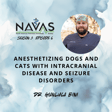
Dr. Matt Gurney: How Librela has Changed the Way European Vets Manage OA Pain in Dogs
In our last episode, we introduced a new class of drugs that have recently hit the veterinary market for treating pain associated with osteoarthritis: nerve growth factor monoclonal antibody therapy. Just over one year ago, Librela (bedinvetmab) entered the North American veterinary market, shaking up our traditional pharmaceutical approach to osteoarthritis pain management in dogs. However, Librela has been available in the United Kingdom and Europe for years Zoetis, the pharmaceutical manufacturer and distributor of Librela, reports that millions of doses of Librela have been administered to dogs since its introduction in 2021, with veterinarians rating their overall satisfaction with the product at about an 8 out of 10.
What can veterinarians in America learn from the experience of European vets about effectively incorporating this novel drug into an overall pain management plan for dogs with osteoarthritis?
Host Dr. Bonnie Gatson chats with UK veterinary anesthesiologist and internationally recognized expert on companion animal pain management, Dr. Matt Gurney. Dr. Gurney is past president of the European College of Veterinary Anesthesia & Analgesia and now works as an anesthesiologist and pain management expert at Eastcott Referrals in the UK. He is also co-founder of Zero Pain Philosophy, an educational resource for veterinary professionals around the globe with a mission to help achieve excellence in veterinary pain management. Together, they discuss how Librela has changed the way European vets manage osteoarthritis pain in dogs, clinical pearls on using Librela in practice, and side effects observed by European vets compared to anecdotal adverse events that have been reported out of the United States.
Resources mentioned in this episode:
The Canine Brief Pain Inventory for dogs
The European and American data sheets on Librela (bedinvetmab)
A comprehensive review of nerve growth factor antibody therapy for the treatment of osteoarthritis pain in humans by Dr. Schmelz
If a patient experiences an adverse event associated with use of Librela, please contact product support at Zoetis at 1-888-963-8471.
Learn more about achieving analgesic excellence at your clinic with Dr. Gurney’s Zero Pain Philosophy. You can check out Zero Pain Philosophy Podcast, wherever you get your podcasts.
Become a member of NAVAS for access to more anesthesia and analgesia educational and RACE-approved CE content.
Our mission: Reduce mortality and morbidity in veterinary patients undergoing sedation, anesthesia, and analgesia through high-quality, peer-reviewed education.
Thank you to our sponsor, Dechra - learn more about the pharmaceutical products Dechra has to offer veterinary professionals, such as Zenalpha.
All opinions stated by the host and their guests are theirs alone and do not represent the thoughts or opinions of any corporation, university, or other business or governmental entity.
Special thanks to Chris Webster, Saul Jimenez, and producer Maria Bridges for making this podcast a reality.











